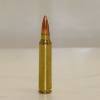Measuring the shoulder set back was the poor mans way I read on here long time ago. A small piece of tube that fits over the end of the bottleneck case and hits the shoulder. Measure the length of a case before sizing and after and subtract, and there is your setback.
Didn't anyone notice this? In order to prevent Mr "
How Great I Art", and "
I've got Datum's to last me all my life" from butting in and telling us that cartridges don't have headspace, because SAAMI does not have a definition for cartridge case headspace, let us invent that definition. Let us call the distance between base and shoulder mating surface on the cartridge case, "
cartridge case headspace". This should not be complicated to understand.
Chamber headspace is measured from the bolt face to the mating surface on the shoulder of the chamber, for rimless. I don't want to hear it about belted or semi rimmed. This is important is that for proper function for the base to shoulder distance on the cartridge case, the "
cartridge case headspace" must be less than the chamber headspace or you won't be able to close the bolt. Does this make sense? If the cartridge is longer than the chamber, you are going to have difficulty closing the bolt. And this is what we are seeing.
We are also reading about a bogus measurement technique that might work for bolt guns, but is certainly not going to work for gas guns. In any manually operated gun, even the fastest, rootin tootin Cowboy cannot jack that lever open while there is the slightest residual barrel pressure left. So that gonzo case headspace measurement technique might work on cartridges fired in lever actions, bolt guns, anything manual. However, gas guns operate on totally different principles. They infact, unlock while there is still residual pressure left in the barrel, and this is done deliberately. This is called the residual blowback effect and the desired out come is to have some pressure, like 650 psia or less pressure, available to pop that cartridge out of the chamber after unlock. Sort of like popping the cork out of a bottle. Of course, too high of residual breech pressure at unlock and the rim gets ripped off the case. We see this all the time too.
The physical effects of this, is that cases gets stretched during extraction. For one thing, the shoulder moves. I have verified this with lubricated cases. Even though the lubricated case does not adhere to the case wall, and thus, I get more positive case extraction, and also I don't get case head separations, the shoulder still moves forward as the internal pressure in the residual breech pressure period is still enough to shape and mold the shoulder to the chamber. Even as the case is extracting!!. Therefore, measuring the "
cartridge case headspace" of a case fired in a gas gun, will not give a true measurement of chamber headspace. Which is the assumption of the OP, or so it seems.
The OP needs to buy a calibrated
cartridge headspace gage . The Sheridan Engineering case gages are pricey, but I love gadgets like this. SAAMI correct minimum chamber and cut outs so you can see what is going on. What is not to like?!


Even a less expensive gauge, such as this Wilson gage, will tell the OP if he is doing something stupid, like setting the cartridge shoulder back when crimping a bullet. Another reason not to crimp bullets, in my opinion!
this is a Walkalong picture set.


Did you understand that the shoulder was bulged during crimping? Having a proper gauge to measure things will reveal this sort of thing. The OP needs to buy a proper gauge and find out if his sizing die is too long or not. If the sizing die is too long, he can grind material off the bottom, just enough, to push the shoulder back so the case fits in the chamber. Sometimes dies are too long, and I have done this. But absolutely, positively, no grinding till the OP gets proper gauges and is able to measure what he is doing!




